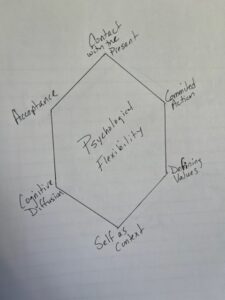Has Acceptance and Commitment Therapy been one of those approaches that you’ve heard of, feel a bit curious about and wonder if it’s worthwhile to dive deeper into it? You are not alone.
For years, I grew more curious about the approach and eventually bought a book I would read sections of here and there. Yet it wasn’t until I had the opportunity to train with a master trainer and long-time practitioner of ACT, Dr. Jonathan Kaplan of SohoCBT+ Mindfulness Center that it all clicked in my brain and in my body and its true value took root for me.
While Acceptance and Commitment Therapy (also referred to as the verb it spells, ACT and not simply the acronym A-C-T) falls under the cognitive behavioral therapy umbrella, it is so much more than simply trying to reframe, control or change the patterns of thoughts.
The goal of ACT is to increase our psychological flexibility and hone our ability to deal with negative thoughts and uncomfortable emotions in healthy and growth-promoting ways. Sounds like just what many of us need, right?
What is so effective about Acceptance is Commitment Therapy is how deftly and pointedly it attends to all levels of our being through its application. By incorporating practices such as mindfulness, self-appraisal and introspection and definition of values and choices into one coherent model as depicted in the Hexaflex.
The Six Core Processes of ACT and the Hexaflex
The Hexaflex is the six-sided, integrative visual model ACT employs to illustrate the six different processes of ACT and their interrelationship in a clear and concise way. There is a Hexaflex depicting the processes leading to both psychological flexibility as well as the alternative or opposite tendencies or processes leading to psychological inflexibility. 
The six core processes of ACT leading to psychological flexibility and health include:
- Acceptance – acknowledging and naming what you feel and think even if it is undesirable and uncomfortable.
- Cognitive Diffusion – the ability to cultivate an observing distance and become less entwined in and reactive to your thoughts.
- Mindfulness/Being Present – practicing being fully present in the moment and not dwelling on past or future.
- Self-as-Context – acknowledging that we are constantly emerging and changing and the importance of fostering self-awareness and self-compassion.
- Defining Valued Directions – identifying core values and what matters most is the crux of directing behaviors and choices in life.
- Committed Action – setting goals that align with your values and making a commitment to take actions to reach those goals is how we move towards making positive change in life.
Alternatively, the ACT model of psychopathology depicts the opposite of the six core processes as noted above as:
- Experiential Avoidance – the unwillingness to stay in contact with aversive sensation and thoughts in your experience
- Cognitive Fusion – attaching to certain patterns of thoughts
- Dominance of Conceptualized Past and Future – our attachment to ruminating about the past or worrying about the future
- Attachment to a Conceptualize Self – how we can see ourselves as defined by the thoughts we have
- Lack of Contact With or Clarity of Values – through experiential avoidance we struggle with contacting what is most meaningful to us
- Inaction, Impulsivity or Avoidant Persistence – avoidance or rigid persistence without clarity results in staying stuck and difficulty making any real, positive, growth-promoting life changes.
We all know that real life will yield its fair share of discomfort. In ACT we ask ourselves “how can we find a way to have a meaningful existence while we encounter unwanted internal experiences.”
Is Acceptance and Commitment Therapy Compatible with Different Therapeutic Approaches and Life Issues?
ACT can be a powerful approach to deepen anyone’s healing process from a variety of core issues and it is compatible with a number of different therapeutic modalities. It is a flexible, pragmatic and impactful approach to psychotherapy that can integrate well with other modalities of care from Dialectical Behavioral Therapy to Somatic Experiencing.
Integrating ACT with Internal Family Systems is a solid example when considering the reach and usefulness that ACT can have. When working from an IFS perspective, exploring our different parts within, cultivating allowance for and a compassionate, observing distance of each part is essential in order to gain a deeper understanding of and work through each part.
Additionally, different aspects of the six core processes of ACT can be utilized with anyone who may be experiencing anxiety or depression, reeling from trauma or grief, struggling with addiction or stress and also relationship issues.
This thumbnail description of the main facets and applications of Acceptance and Commitment Therapy is designed to encourage you to learn more about ACT. Looking at the diagram of the Hexaflex here or even reading this brief description of the core processes and goals of ACT is a world apart from learning about it through didactic and interactive instruction and experiencing the practices within yourself. Be sure to find a live training that you can participate in and experience first hand the impact that Acceptance and Commitment Therapy can have in your life.
JOIN US IN OUR NEXT LIVE VIRTUAL CE CLASS: ACT LIKE YOU MEAN IT! A THOROUGH AND EXPERIENTIAL INTRODUCTION TO ACCEPTANCE AND COMMITMENT THERAPY.



